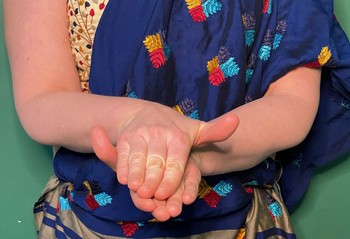Nartananirṇaya: Saṃyuta Hasta (Double Hand Gestures)
1500 CE - 1600 CE - by Puṇḍarīka Viṭṭhala
Saṃyuta Hasta - Double Hand Gestures
Nartananirṇaya - Language: Sanskrit
The author is thought to be a South Indian, who migrated between courts, eventually writing this text for the Emperor Akbar. The text talks about drama, music, and dance - much like the Natya Sastra, but includes more modern concepts. Bose describes it as the missing link between ancient and current classical dance.
Descriptions and Meanings
7:103
Wherein in añjali the roots, tips and sides are mutually joined in between each other (and the tips of thumbs touch each other) it is karkaṭa.
7:104
Dola is [formed] by two patāka hands, palms upturned and joined together.
7:107
Two śukatuṇḍas, joined face to face, if [placed] at the chest [form] avahittha.
7:106
Two sarpaśiras-hastas placed each at the opposite elbow [form] gajadanta.
7:109
Two ardhacandra hastas joined well at the sides of the palms [form] dardura.
7:110
If two muṣṭi hastas are placed one above the other facing up, it is yogamusti.
7:110
If two śikhara hastas are joined, face upwards, at the tips, it is dviśikhara.










